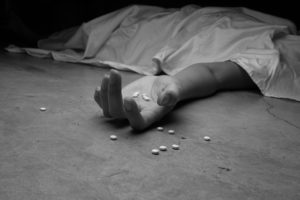Opiate withdrawal symptoms are potentially life-threatening and manifest as a result of opiate dependence. Opioids or opiates are a class of drugs that act in the nervous system prescribed to relieve pain. Opiate withdrawal occurs when a person who is dependent on opiates suddenly reduces or stops taking the drugs. Trying to quit opiate “cold turkey” is difficult and dangerous to do on your own. For safety, it is best to seek the help of medically-assisted detox staff in order to overcome the Opiate withdrawal symptoms safely and effectively.
Opiates have a high potential for causing addiction in some people, even when the medications are taken as prescribed. Addiction to opiates can cause life-threatening health problems, including the risk of overdose. An overdose happens when high doses of these drugs cause life-threatening side effects, such as causing breathing to slow or stop. As a result, it may lead to unconsciousness and death. Chronic opiate use can lead to the development of potentially incapacitating dependence, according to the National Center for Biotechnology Information [1].

According to the Center for Disease Control and Prevention (CDC) [2], although these terms are often used interchangeably, they are different. Opiates refer to natural opioids such as heroin, morphine, and codeine, while opioids refer to all-natural, semisynthetic, and synthetic opioids.
The individual indicators of opiate addiction might seem harmless in isolation and passed off as some other health condition. Learning how to recognize this kind of substance abuse disorder can save someone’s life. Both licit and illicit types of opioids carry a high risk of being habit-forming. When opiates interact with an endorphin receptor, they cause heightened levels of endorphin activity. As a result, it creates a powerful high, followed by an artificial feeling of calm and relaxation.
Opiate Withdrawal Symptons
Opiate drugs, including prescription painkillers and heroin, can produce Opiate withdrawal symptoms just hours after the last dose.
Early Symptoms of Opiate Withdrawal
These usually start within 6-12 hours for short-acting opiates. And they start within 30 hours for longer-acting ones:
- Tearing up
- Muscle Aches
- Agitation
- Trouble falling and staying asleep
- Excessive Yawning
- Anxiety
- Nose Running
- Sweats
- Racing Heart
- Hypertension
- Fever
- High blood pressure
- Hallucinations
- Seizures

Late-Onset Symptoms of Opiate Withdrawal
These peak within 72 hours and usually last a week or so:
- Nausea and vomiting
- Diarrhea
- Fever
- Goosebumps
- Stomach cramps
- Depression
- Drug cravings
- High blood pressure
- Hallucinations
- Seizures
There is no set time frame of how long it takes to become physically or psychologically dependent on opiates. However, there are several factors that can cause certain individuals to be more likely to develop an addiction than others. Those with the highest chances are those with a psychological disorder and those who have experienced substance abuse in the past. Being older is also a factor that can make addiction more likely. Unassisted Opiate Withdrawal can be highly uncomfortable. People may relapse if they do not receive professional medical treatment to help relieve withdrawal symptoms.
Opiate Withdrawal Timeline
Many people become dependent on these drugs in order to avoid pain or opiate withdrawal symptoms. In some cases, people don’t even realize that they’ve become dependent. They may mistake withdrawal for symptoms of the flu or another condition. The symptoms can last a few days to more than 2 weeks. For most people, the worst symptoms get better after a few days.
Anticipatory Stage
3 to 4 hours after the last dose
The anticipatory stage usually begins with an increase in anxiety or fear in connection to incoming symptoms of Opiate withdrawal. This stage includes cravings and drug-seeking behavior.
Early Acute Stage
8 to 10 hours after the last dose
Anxiety and restlessness begin to increase during this time. A person may experience flu-like symptoms such as nausea, vomiting, sweating, and stomach aches. Cravings and drug-seeking behavior still persist.
Fully-Developed Acute Stage
1 to 3 days after the last dose
Symptoms have reached their peak at this stage. Individuals will typically experience body tremors, muscle spasms, diarrhea, insomnia, and increased blood pressure. Cravings are strongest during this period.
PAWS (Post-Acute Withdrawal Syndrome)
Up to 24 months after the last dose
Acute symptoms are no longer present in this stage. However, individuals may have mood swings, cravings, drug dreams, anxiety, depression, irritability or agitation, insomnia, and poor concentration. A person is still highly susceptible to environmental triggers that may encourage them toward relapse.
Opiate Dependence
Opiate dependence is when the human body requires continuous use of opiate medications in order to prevent the onset of physical withdrawal symptoms. Dependence develops over time as the actual brain composition changes in an effort to adapt to the influx of dopamine. Usually, dependence happens due to long-term opiate use and increased doses consumed in an effort to achieve the same level of pain relief. An individual can experience physical dependence without developing an opiate use disorder, the medical term for addiction.
Opiate Addiction
The Diagnostic and Statistical Manual of Mental Disorders (DSM-V) classifies addictions as mild, moderate, or severe substance use disorder. Addiction is defined as “a brain disease that is manifested by compulsive substance use despite harmful consequence”. In reality, an addiction is when an individual continues to use drugs even when they face consequences such as health issues, job loss, relationship problems, and legal charges caused by drug use. Just as dependence can be present without addiction, addiction can develop without dependence. However, in the event of addiction, the development of dependence is almost inevitable.
Unfortunately for those with dependency, the detox process is the first step to recovery helping you with opiate withdrawal and other symptoms.
Opiate Dependence vs. Addiction Treatment
As opiate dependence and addiction are so closely related, most individuals who struggle with opiates in any manner start treatment in a detox program. Detox facilities are ideal for the first days of recovery as they are equipped to address the potential physical and psychological symptoms of discontinuing opiate use. Those who are dependent on opiates, but not addicted, may complete treatment after detox. In reality, all users can benefit from a long-term individualized treatment plan. Those struggling with addiction should also enroll in an inpatient or outpatient treatment program that helps clients develop the skills and tools to maintain sobriety long term.
Opiate Detox and Treatment
Heroin, fentanyl, hydrocodone, oxycodone, and Dilaudid are just a handful of the substances that fall into the opioid and opiate categories. These substances are all highly addictive. In fact, there are approximately 2.1 million Americans that have an opioid and opiate use disorder. Due to the highly addictive nature of these substances, recovery rates from this addiction are low. Additionally, overdose rates have been climbing over the past couple of decades. In order to reduce overdose rates and help those struggling with opiate addiction, a few different pharmaceutical medications have been developed and approved by the FDA. Two of the most common medications used for opiate-related treatment include Suboxone and Methadone.
Both Methadone and Suboxone are Schedule II controlled substances. When used, they carry a risk of withdrawal and a high potential for misuse. When starting these medications, their administration is closely monitored and controlled. In many cases, the medical professional administering the drug will require that the patient is only given it at their facility, and they will even observe the patient take the medication. Over time, the individual may be given a few doses at a time to administer themselves.
We Level FL Mental Health Center: Primary Mental Health Treatment with Secondary Co-Occurring Treatment
We Level Up FL primary mental health center stands ready to help. Offering secondary treatment therapy for underlying problems like Opiate Drug Addiction often fuels negative behaviors. Taking that first step to get the help you deserve can be life-changing.
We understand how behavioral disorders and secondary co-occurring addiction diagnoses directly impact each other. We Level Up Florida can instill a support system through our mental health treatments that can make you feel valuable. Call us now for a free mental health assessment! Inpatient medical detox and residential primary addiction treatment may be available at our affiliated facility at Level Up Treatment West Palm Beach.
Sourc